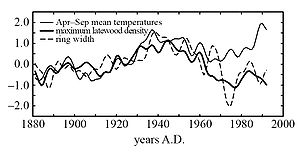- Divergence problem
-
 Twenty-year smoothed plots of averaged ring-width (dashed) and tree-ring density (thick line), averaged across all sites, and shown as standardized anomalies from a common base (1881-1940), and compared with equivalent-area averages of mean April–September temperature anomalies (thin solid line). From Briffa 1998 [1].
Twenty-year smoothed plots of averaged ring-width (dashed) and tree-ring density (thick line), averaged across all sites, and shown as standardized anomalies from a common base (1881-1940), and compared with equivalent-area averages of mean April–September temperature anomalies (thin solid line). From Briffa 1998 [1].
The divergence problem is an anomaly from the field of dendroclimatology, the study of past climate through observations of old trees, primarily the properties of their annual growth rings. It is the disagreement between the temperatures measured by the thermometers (instrumental temperatures) and the temperatures reconstructed from the widths of tree rings in the far northern forests.
While the thermometer records indicate a substantial warming trend, many tree rings do not display a corresponding change in their width.[2] A temperature trend extracted from tree rings alone would not show any substantial warming. The temperature graphs calculated in these two ways thus "diverge" from one another since the 1950s, which is the origin of the term.
Samples from southern forests do not exhibit this divergence, though this could be due to paucity of samples, and not all trees in the northern hemisphere do. Divergence is most common in the far northern hemisphere.
Contents
Importance
The deviation of some tree ring proxy measurements from the instrumental record since the 1950s raises the question of the reliability of tree ring proxies in the period before the instrumental temperature record. The wide geographic and temporal distribution of well-preserved trees, the solid physical, chemical, and biological basis for their use, and their annual discrimination make dendrochronology particularly important in pre-instrumental climate reconstructions. Tree ring proxies are essentially consistent with other proxy measurements for the period 1600–1950. Before around AD 1600, the uncertainty of temperature reconstructions rises due to the relative paucity of data sets and their limited geographic distribution. At present, these uncertainties are too great to allow conclusion on whether the tree ring record diverges from other proxies during this period.[3]
Possible explanations
The explanation for the divergence problem is still unclear, but is likely to represent the impact of some other climatic variable that is important to modern northern hemisphere forests but not significant before the 1950s. Rosanne D'Arrigo, senior research scientist at the Tree Ring Lab at Columbia University's Lamont-Doherty Earth Observatory, hypothesises that "beyond a certain threshold level of temperature the trees may become more stressed physiologically, especially if moisture availability does not increase at the same time." Signs suggestive of such stress are visible from space, where satellite pictures show "evidence of browning in some northern vegetation despite recent warming." [4] Other possible explanations include that the response to recent rapid global warming might be delayed or nonlinear in some fashion. The divergence might represent changes to other climatic variables to which tree rings are sensitive, such as delayed snowmelt and changes in seasonality. Growth rates could depend more on annual maximum or minimum temperatures, especially in temperature limited growth regions (ie high latitudes and altitudes). Another possible explanation is global dimming due to atmospheric aerosols.[2]
References
- ^ Briffa, K. "Trees tell of past climates: but are they speaking less clearly today?", Proceedings of the Royal Society 1998
- ^ a b D'Arrigo, Rosanne; Wilson, Rob; Liepert, Beate; Cherubini, Paolo (2008). "On the ‘Divergence Problem’ in Northern Forests: A review of the tree-ring evidence and possible causes". Global and Planetary Change (Elsevier) 60: 289–305. doi:10.1016/j.gloplacha.2007.03.004. http://www.ldeo.columbia.edu/~liepert/pdf/DArrigo_etal.pdf.
- ^ Surface temperature reconstructions for the last 2, 000 years. Washington, D.C: National Academies Press. 2006. ISBN 0-309-10225-1.
- ^ Christian Science Monitor, December 14, 2009 Climategate, global warming, and the tree rings divergence problem, last accessed 2009-12-22
External links
- Curiosity Rises With Trees' Strange Growth Spurt, NPR, March 28, 2010
Categories:
Wikimedia Foundation. 2010.
